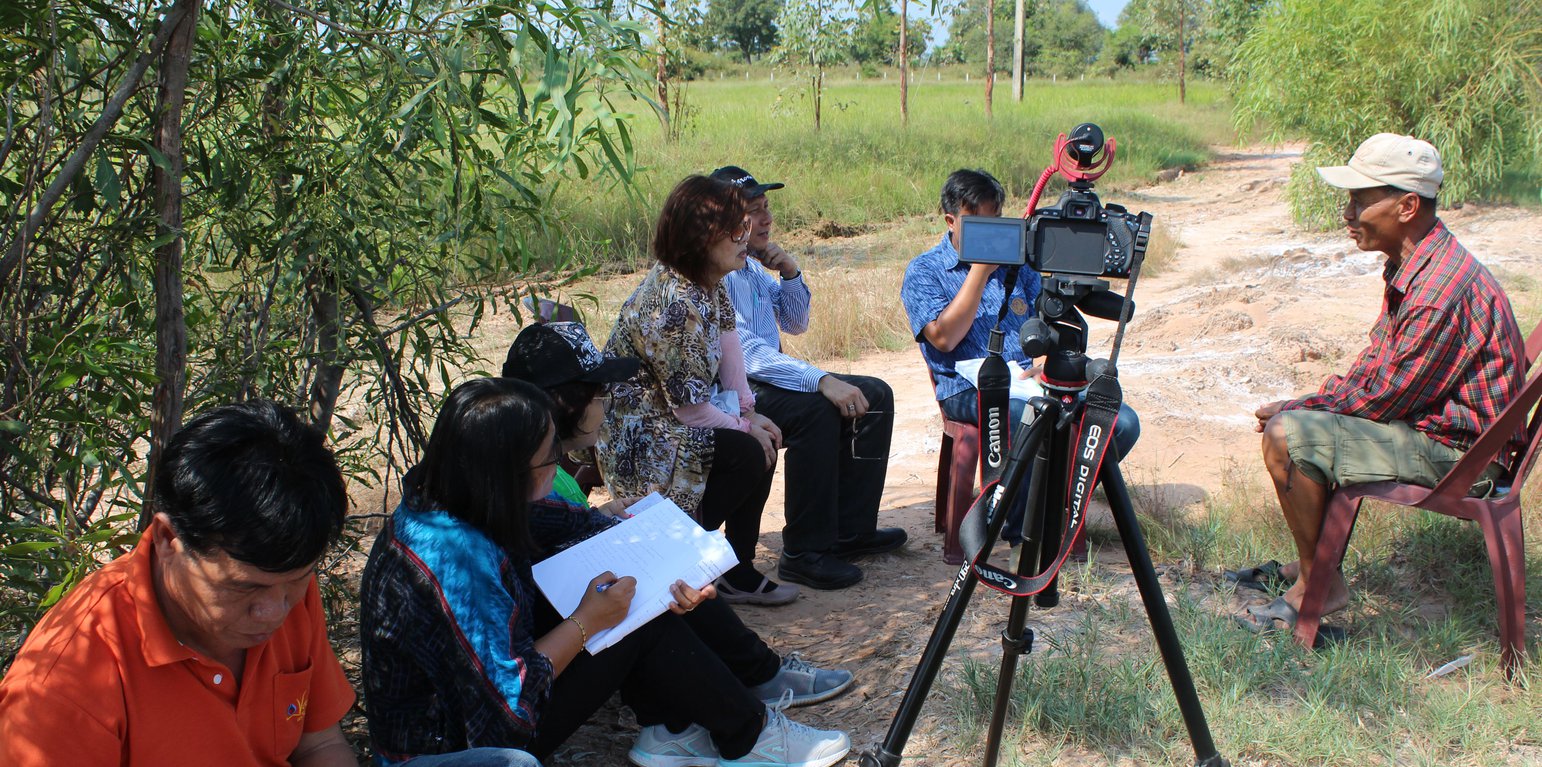Promotion of Acacia ampliceps on severely salt-affected soil
(Tailandia)
Planting Acacia ampliceps on severely salt-affected land.
Descripción
Planting perennial salt-tolerant trees in the severely salt-affected area in Lam Satad of Chi-Mun watershed was introduced by the Land Development Department at A. Buayai, Nakhon Ratchasima. This project aimed at promoting the planting of Acacia ampliceps on an area of up to 4,665 rai (approx. 745 ha).
Land rehabilitation through Acacia ampliceps planting on severely salt-affected soils has been a subproject of the LDD project on "Planting Perennial Salt-tolerant Trees in Salt-affected Areas in the Northeast of Thailand", which started in 1996. The area of Acacia ampliceps has extended further than 10,000 rai (approx. 1600 hectares) through public relations, demonstration plots, collaboration of community leaders, the local governmental administration, and community volunteers on soil improvement and land users.
The soil salinity map (LDD, 1995) shows that the severely salt-affected land in Northeast Thailand covers 475,200 rai. One of the technologies to address salinity is to decrease the saline shallow groundwater level by planting salt-tolerant trees - which are low input compared with engineering measures. The LDD has been extensively planting Acacia ampliceps through close collaboration and participation of stakeholders and demonstration plots in many severely salt-affected locations of several sub-watersheds, one of the sites being Lam Satad of Chi-Mun watershed. The objectives of the approach are (1) to extend the area of planting Acacia ampliceps to prevent and decrease salination, (2) to maximize the use of salt-affected land for a better environment and crop production, and (3) to extend the knowledge of vegetative measures for salinity control to land users and laymen.
The methods used are through (1) demonstration plots of Acacia ampliceps - planting 2-month-old seedlings in pits as single rows at 80 trees per rai (500 per hectare); (2) the land users got to know the approach through public relations media, local administration, community soil doctor volunteers on soil improvement, community leaders, SLM specialists, and researchers; (3) selection of interested land users under LDD requirements; (4) training of selected land users after joining the project, and (5) monitoring and evaluation after 1 year of planting.
Stakeholders involved are LDD researchers and SLM specialists responsible for establishing planting methods, preparation of land (land leveling and beds for planting), production of seedlings and carrying out demonstration plots, as well as monitoring and evaluation and training at the beginning of planting in new areas. The local administration and community soil doctor volunteers on soil improvement are involved in public relations, recommendations, and strengthening closer participation among farmers. Land users/farmers are to be trained and instructed to follow the technology by SLM specialists. They also participate in the monitoring and evaluation and persuade other land users/farmers to plant Acacia ampliceps.
The land users/farmers favour the technology because they have observed that salinity could be controlled, and they utilize the trees as shade for cattle and the tree branches for producing charcoal. Besides, the land users are self-organized as a group to watch and protect the young trees from being trampled by cattle. The disadvantage of Acacia ampliceps is its sensitivity to flash floods and forest fires. Furthermore, the direct production from the trees is low.
Lugar
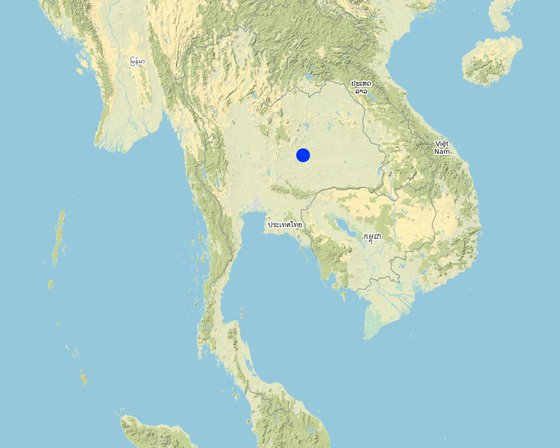
Lugar: Ban Kok Sa-ard, Moo 10 T. Danchang, A. Buayai, Nakhon Ratchasima, Tailandia
Georreferencia de sitios seleccionados
Dato de inicio: 2014
Año de conclusión: 2017
Tipo de Enfoque
-
tradicional/ local
-
iniciativa local reciente/ innovadora
-
proyecto/ basado en un programa
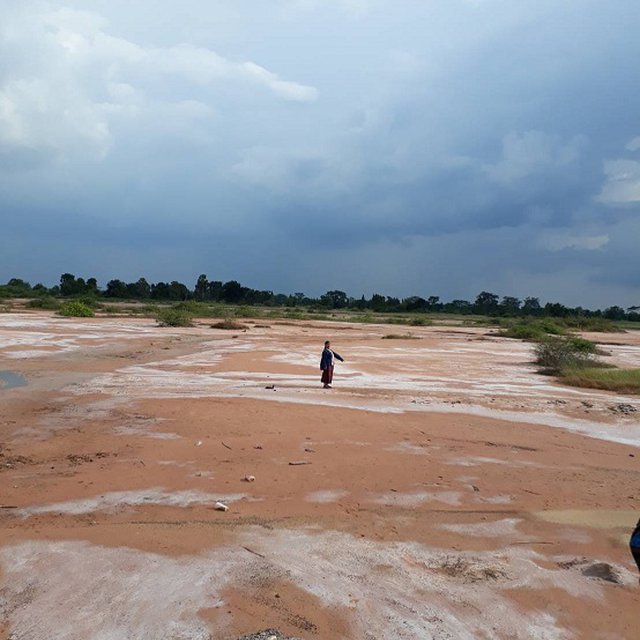
The severely salt-affected barren land before planting Acacia ampliceps. (Prasit Prawanna)
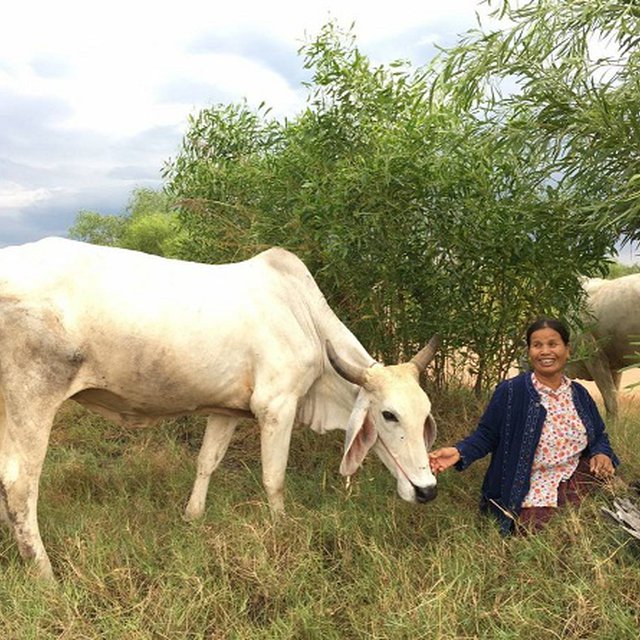
A happy land user with native grasses re-emerging after 2 years of planting trees. (Prasit Prawanna)
Metas del Enfoque y entorno facilitador
Propósitos/ objetivos principales del Enfoque
The purpose is to scale-out the approach to persuade farmers on severely salt-affected land in other districts and provinces to grow Acacia ampliceps.
Condiciones que facilitan la implementación de la/s Tecnología/s aplicadas bajo el Enfoque
-
Normas y valores sociales/ culturales/ religiosos: Farmers have mutual respect for the community leader and for each other.
-
Disponibilidad/ acceso a recursos y servicios financieros : Farmers can access the financial resources through the housing fund.
-
Entorno institucional: Public relations is done by Sub-district Administration Organization (SAO).
-
Colaboración/ coordinación de actores: Community leaders, soil doctors (soil improvement volunteers) and successful farmers are working together.
-
Políticas: Thai government has a policy of rehabilitating salt-affected soils.
-
Conocimiento de MST, acceso a apoyo técnico: LDD officers educate farmers in study areas.
Condiciones que impiden la implementación de la/s Tecnología/s aplicadas bajo el Enfoque
Participación y roles de las partes interesadas involucradas
Partes interesadas involucradas en el Enfoque y sus roles
| ¿Qué partes interesadas/ entidades implementadoras estuvieron involucradas en el Enfoque? |
Especifique las partes interesadas |
Describa los roles de las partes interesadas |
| usuarios locales de tierras/ comunidades locales |
The LDD officers, community leader, soil doctors (soil improvement volunteers) and local administration officers. |
Provide knowledge of the technology. |
| especialistas MST/consejeros agrícolas |
SLM specialist, community leader, soil doctors (soil improvement volunteers) and local administration officers. |
Technology transfer and implementation |
| gobierno local |
Local administration / Community leader |
Public relations and coordination |
Agencia líder
The LDD officers had extensively worked through close collaboration and participation of community leaders, soil doctors (soil improvement volunteers) and local administration officers.
Involucramiento de los usuarios locales de tierras/ comunidades locales en las distintas fases del Enfoque
ninguno
pasivo
apoyo externo
interactivo
auto-movilización
iniciación/ motivación
Training and demonstration plot was held in the study area.
planificación
Public hearing planning was set up before the beginning of the project.
implementación
Some farmers were hired labourers in this project.
monitoreo y evaluación
Volunteer soil doctors and community volunteers were in charge of the coordination.
Flujograma
Flow chart shows three phases of the implementation and approach.
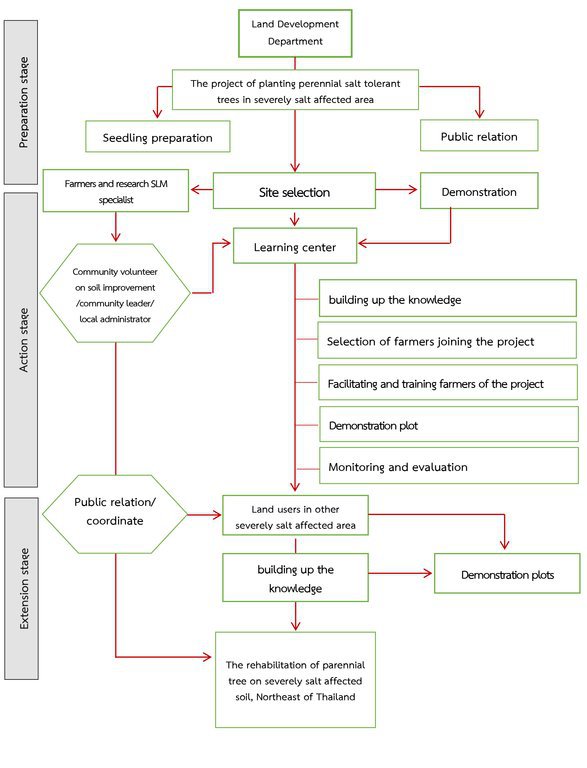
Autor: Mrs. Phatranit Chuaysanoi
La toma de decisiones en la selección de Tecnología MST
Las decisiones fueron tomadas por
-
solamente usuarios de tierras (autoiniciativa)
-
principalmente usuarios de tierras con el apoyo de especialistas MST
-
todos los actores relevantes, como parte de un enfoque participativo
-
principalmente por especialistas MST en consulta con usuarios de tierras
-
solo por especialistas MST
-
por políticos/ líderes
La toma de decisiones se basa en
-
la evaluación de conocimiento MST bien documentado (la toma de decisiones se basa en evidencia)
-
hallazgos de investigaciones
-
la experiencia personal y opiniones (no documentadas)
Apoyo técnico, fortalecimiento institucional y gestión del conocimiento
Las siguientes actividades o servicios fueron parte del enfoque
-
Construcción de capacidades / capacitación
-
Servicio de asesoría
-
Fortalecimiento institucional (desarrollo institucional)
-
Monitoreo y evaluación
-
Investigación
Construcción de capacidades/ capacitación
Se proporcionó capacitación a las siguientes partes interesadas
-
usuarios de tierras
-
personal de campo/ consejeros
Forma de capacitación
-
en el contexto de trabajo
-
de agricultor a agricultor
-
áreas de demostración
-
reuniones públicas
-
cursos
Temas avanzados
The rehabilitation of severely salt-affected soils by growing Acacia ampliceps could reduce household expenditure and is easy to follow.
Servicio de asesoría
Se proporcionó servicio de asesoría
-
en los campos de los usuarios de tierras
-
en centros permanentes
1. LDD officers educate farmers in the study area.
2. There is cooperation among community leaders, volunteer soil doctors (soil improvement volunteers) and successful farmers.
Monitoreo y evaluación
LDD officers are in charge of monitoring, investigating survival rates and planning for replanting in the next cropping season.
Investigación
La investigación trató los siguientes temas
-
sociología
-
economía/ marketing
-
ecología
-
tecnología
Financiamiento y apoyo material externo
Presupuesto anual en dólares americanos para el componente MST
-
< 2,000
-
2,000-10,000
-
10,000-100,000
-
100,000-1,000,000
-
> 1,000,000
Precise annual budget: n.d.
Land Development Department
Los siguientes servicios o incentivos fueron proporcionados a los usuarios de las tierras
-
Apoyo financiero/material proporcionado a los usuarios de tierras
-
Subsidios para insumos específicos
-
Crédito
-
Otros incentivos o instrumentos
Apoyo financiero/material proporcionado a los usuarios de tierras
Cost of compost, fertilizer, rice husks, Acacia ampliceps seedlings
parcialmente financiado
totalmente financiado
mano de obra
Plantation and maintenance
agrícola: semillas
Free seedlings
agrícola: semillas: fertilizantes
Free compost, rice husk and chemical fertilizer with 15-15-15 formula
farm rigged
Reshape of farm ridge
El trabajo de los usuarios de las tierras fue
-
voluntario?
-
comida por trabajo?
-
pagado en efectivo?
-
recompensado con otro tipo de apoyo material?
Análisis de impacto y comentarios de conclusión
Impactos del Enfoque
No
Sí, un poco
Sí, moderadamente
Sí, mucho
¿El Enfoque empoderó a los usuarios locales de tierras, mejoró el involucramiento de las partes interesadas?
To develop food security and reduce farm household
¿El Enfoque facilitó la toma de decisiones basada en evidencia?
Learning center and source of information in the decision-making process on technology adoption
¿El Enfoque ayudó a los usuarios de tierras a implementar y mantener Tecnologías MST?
Farmers were taking care of technology because it causes of expenditure reduction
¿El Enfoque movilizó/mejoró el acceso a recursos financieros para implementar MST?
It would be a guarantee for loan deposit
¿El Enfoque mejoró el conocimiento y capacidades de los usuarios para implementar MST?
Self-adaptation and changing of SLM patterns
¿El Enfoque mejoró el conocimiento y capacidades de otras partes interesadas?
Government agencies and the private sector development patterns of SLM
¿El Enfoque llevó a un acceso mejorado a tierra y saneamiento?
According to technology adoption, it could result in desalinization and income enhancement
Motivación principal del usuario de la tierra para implementar MST
-
producción incrementada
-
incremento de la renta(bilidad), proporción mejorada de costo-beneficio
-
reducción de la degradación de la tierra
-
reducción del riesgo de desastres naturales
-
carga de trabajo reducida
-
pagos/ subsidios
-
reglas y reglamentos (multas)/ aplicación
-
prestigio, presión social/ cohesión social
-
afiliación al movimiento/ proyecto/ grupo/ redes
-
conciencia medioambiental
-
costumbres y creencias, moral
-
conocimiento y capacidades mejorados de MST
-
mejoramiento estético
-
mitigación de conflicto
Sostenibilidad de las actividades del Enfoque
¿Pueden los usuarios de tierras sostener lo que se implementó mediante el Enfoque (sin apoyo externo)?
Most farmers have a good understanding of the rehabilitation of Acacia ampliceps on severely salt-affected soils. Moreover, farmers can get benefit of expenditure reduction through utilization of tree branches as charcoal.
Conclusiones y lecciones aprendidas
Fortalezas: perspectiva del usuario de tierras
-
1) Acacia ampliceps is a perennial salt-tolerant tree, which can grow well in the severely salt-affected area.
-
2) Desalinization resulted from Acacia ampliceps plantation after 2 years of planting, native grasses return and become grazing land.
-
3) Tree branches of Acacia ampliceps could be utilized as charcoal; and the land was changed from barren to trees that become shading.
-
4) Soil doctors (soil improvement volunteers) were in charge of coordination.
Fortalezas: punto de vista del compilador o de otra persona recurso clave
-
1) There were LDD officers working with a community leader, soil doctors (soil improvement volunteers) and SAO (Sub-district Administration Organization) officers, who can suggest and support necessary information to the farmer.
-
2) Land Development Department operates demonstration plots.
Debilidades/ desventajas/ riesgos: perspectiva del usuario de tierrascómo sobreponerse
-
1) If a farmer does not engage with this project, he will have no knowledge how to plant Acacia ampliceps in the farm. Moreover, he will not know where to buy Acacia ampliceps seeds.
The LDD has extensively worked through close collaboration and participation of community leader, soil doctors (soil improvement volunteers) and local administration officers on public relations and persuade other land users/ farmers to plant Acacia ampliceps.
Debilidades/ desventajas/ riesgos: punto de vista del compilador o de otra persona recurso clavecómo sobreponerse
-
1) If a farmer doesn’t engage with this project, they don’t have knowledge how to desalinization by planting Acacia ampliceps. Moreover, they don’t know that severely salt-affected soils become less saline to become rice field after 3 years of planting Acacia ampliceps.
There must have training/ suggesting farmers to know the benefits of Acacia ampliceps planting.
Referencias
Revisado por
-
Samran Sombatpanit
-
Rima Mekdaschi Studer
-
William Critchley
Fecha de la implementación: 16 de noviembre de 2018
Últimas actualización: 7 de enero de 2021
Personas de referencia
-
Phatranit Chuaysanoi (phatraniton@gmail.com) - Especialista MST
-
Nurean Tathaisong - Usuario de la tierra
-
Chartee Panikom - Usuario de la tierra
-
Mongkoen Salanok - Usuario de la tierra
-
TubseKaew Palinee - Usuario de la tierra
-
Kumpu Ponrat - Soil doctor volunteer
-
Pakorn Pawanna - Assistant of village leader
-
Chakkaphan Phaosrakhu (yom42@hotmail.com) - Especialista MST
-
Kaewjai Oechaiyaphum (issabellalala@gmail.com) - Especialista MST
-
Saowanee Prachansri (prachansri@gmail.com) - Especialista MST
-
Apisit Phiprakon - Especialista MST
-
Prasit Prawanna - Especialista MST
-
Somsri Arunin (ssarunin@gmail.com) - National Consultant
-
- Especialista MST
Descripción completa en la base de datos de WOCAT
La documentación fue facilitada por
Institución
- Land Development Department LDD (Land Development Department LDD) - Tailandia
Proyecto
- Decision Support for Mainstreaming and Scaling out Sustainable Land Management (GEF-FAO / DS-SLM)
Referencias claves
-
Land Development Department: http://www.ldd.go.th/
Vínculos a la información relevante disponible en línea
